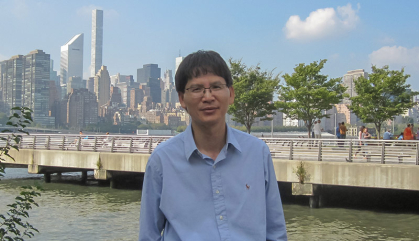Rutgers professor's proofs will provide deeper understanding of math mysteries and may lead to advances in science and technology
A Rutgers University-New Brunswick professor who has devoted his career to resolving the mysteries of higher mathematics has solved two separate, fundamental problems that have perplexed mathematicians for decades.
The solutions to these long-standing problems could further enhance our understanding of symmetries of structures and objects in nature and science, and of long-term behavior of various random processes arising in fields ranging from chemistry and physics to engineering, computer science and economics.
Pham Tiep, the Joshua Barlaz Distinguished Professor of Mathematics in the Rutgers School of Arts and Science's Department of Mathematics, has completed a proof of the 1955 Height Zero Conjecture posed by Richard Brauer, a leading German-American mathematician who died in 1977. Proof of the conjecture - commonly viewed as one of the most outstanding challenges in a field of math known as the representation theory of finite groups - was published in the September issue of the Annals of Mathematics.

"A conjecture is an idea that you believe has some validity," said Tiep, who has thought about the Brauer problem for most of his career and worked on it intensively for the past 10 years. "But conjectures have to be proven. I was hoping to advance the field. I never expected to be able to solve this one."
In a sense, Tiep and his colleagues have been following a blueprint of challenges Brauer laid out for them in a series of mathematical conjectures posed and published in the 1950-60s.
"Some mathematicians have this rare intellect," Tiep said of Brauer. "It's as though they came from another planet or from another world. They are capable of seeing hidden phenomena that others can't."
In the second advance, Tiep solved a difficult problem in what is known as the Deligne-Lusztig theory, part of the foundational machinery of representation theory. The breakthrough touches on traces, an important feature of a rectangular array known as a matrix. The trace of a matrix is the sum of its diagonal elements. The work is detailed in two papers, one was published in Inventiones mathematicae, vol. 235 (2024), the second in Annals, vol. 200 (2024).
"Tiep's high-quality work and expertise on finite groups has allowed Rutgers to maintain its status as a top world-wide center in the subject," said Stephen Miller, a Distinguished Professor and Chair of the Department of Mathematics. "One of the great accomplishments in 20th century mathematics was the classification of the so-called but perhaps misleadingly named 'simple' finite groups, and it is synonymous with Rutgers - it was led from here and many of the most interesting examples were discovered here. Through his amazing stretch of strong work, Tiep brings international visibility to our department."
Insights from the solution are likely to greatly enhance mathematicians' understanding of traces, Tiep said. The solution also provides insights that could lead to breakthroughs in other important problems in mathematics, including conjectures posed by the University of Florida mathematician John Thompson and the Israeli mathematician Alexander Lubotzky, he added.
Both breakthroughs are advances in the field of representation theory of finite groups, a subset of algebra. Representation theory is an important tool in many areas of math, including number theory and algebraic geometry as well as in the physical sciences, including particle physics. Through mathematical objects known as groups, representation theory also has been used to study symmetry in molecules, encrypt messages and produce error-correcting codes.
Following the principles of representation theory, mathematicians take abstract shapes that exist in Euclidean geometry - some of them extremely complex - and transform them into arrays of numbers. This can be achieved by identifying certain points that exist in each three- or higher-dimensional shape and converting them to numbers placed in rows and columns.
The reverse operation must work, too, Tiep said: One needs to be able to reconstitute the shape from the sequence of numbers.
Unlike many of his colleagues in the physical sciences who often employ complex devices to advance their work, Tiep said he uses only a pen and paper to conduct his research, which so far has resulted in five books and more than 200 papers in leading mathematical journals.
He jots down math formulas or sentences indicating chains of logic. He also engages in continual conversations - in person or on Zoom - with colleagues as they proceed step by step through a proof.
But progress can come from internal reflection, Tiep said, and ideas burst forth when he is least expecting it.
"Maybe I'm walking with our children or doing some gardening with my wife or just doing something in the kitchen," he said. "My wife says she always knows when I'm thinking about math."
On the first proof, Tiep collaborated with Gunter Malle of Technische Universität Kaiserslautern in Germany, Gabriel Navarro of Universitat de València in Spain and Amanda Schaeffer Fry, a former graduate student of Tiep's who is now at the University of Denver.
For the second breakthrough, Tiep worked with Robert Guralnick of the University of Southern California and Michael Larsen of Indiana University. On the first of two papers that tackle the mathematical problems on traces and solve them, Tiep worked with Guralnick and Larsen. Tiep and Larsen are co-authors of the second paper.
"Tiep and coauthors have obtained bounds on traces which are about as good as we could ever expect to obtain," Miller said. "It's a mature subject which is important from many angles, so progress is hard - and applications are many."






